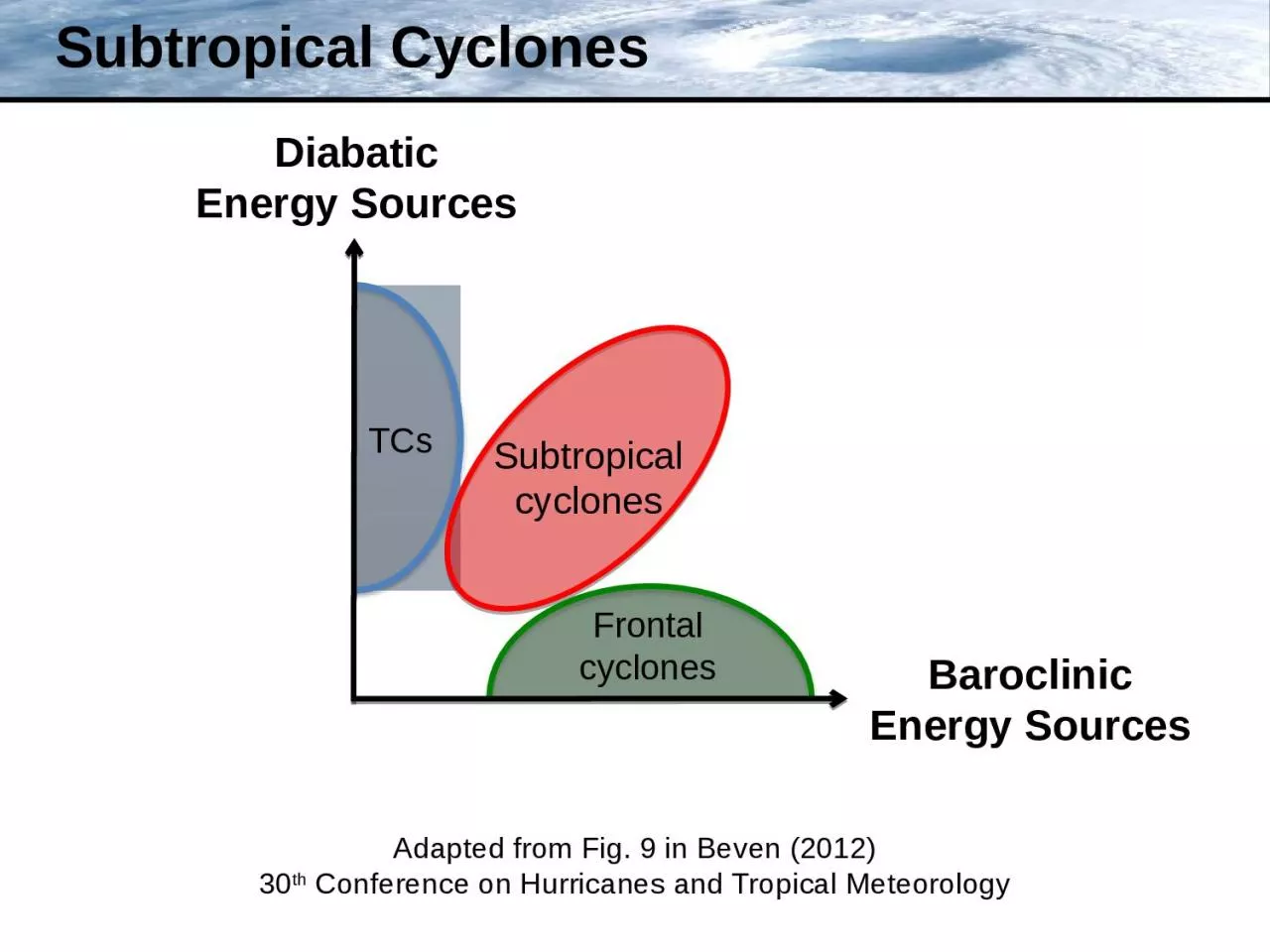

Energy Sources Baroclinic Energy Sources Adapted from Fig 9 in Beven 2012 30 th Conference on Hurricanes and Tropical Meteorology TCs Subtropical cyclones Frontal cyclones Davis 2010 methodology ID: 1021019
Download Presentation The PPT/PDF document "Subtropical Cyclones Diabatic" is the property of its rightful owner. Permission is granted to download and print the materials on this web site for personal, non-commercial use only, and to display it on your personal computer provided you do not modify the materials and that you retain all copyright notices contained in the materials. By downloading content from our website, you accept the terms of this agreement.
1. Subtropical CyclonesDiabaticEnergy SourcesBaroclinicEnergy SourcesAdapted from Fig. 9 in Beven (2012)30th Conference on Hurricanes and Tropical MeteorologyTCsSubtropical cyclonesFrontal cyclones
2. Davis (2010) methodology:Based on Ertel potential vorticity (PV)Formulated in terms of two PV metrics that quantify the relative contributions of baroclinic processes and condensation heating to the evolution of individual cyclonesDavis (2010) methodology is similar to Hart (2003) cyclone phase space diagramsAdapted Davis (2010) Methodology
3. Adapted Davis (2010) MethodologyLower-troposphericbaroclinic processes:(near-surface potentialtemperature anomaly)absolute vorticity425 hPaPotential temperature anomaly Length of 6° box centered on cyclone
4. Adapted Davis (2010) Methodology PV1/PV2 : measure of the contribution of lower-troposphericbaroclinic processes relative to the contribution of condensation heatingLower-troposphericbaroclinic processes:(near-surface potentialtemperature anomaly)Midtroposphericlatent heat release:(interior PV anomaly)425 hPaErtel PV anomaly Potential temperature anomaly Length of 6° box centered on cycloneabsolute vorticity
5. Adapted Davis (2010) Methodology200 hPa925 hPa
6. Lower-tropospheric baroclinic processes (PV1)200 hPa925 hPaAdapted Davis (2010) MethodologyLower-troposphericbaroclinic processes:(near-surface potentialtemperature anomaly)
7. Lower-tropospheric baroclinic processes (PV1)200 hPa925 hPaAdapted Davis (2010) MethodologyLower-troposphericbaroclinic processes:(near-surface potentialtemperature anomaly)Midtroposphericlatent heat release:(interior PV anomaly)
8. 500 hPaLower-tropospheric baroclinic processes (PV1)200 hPa925 hPaAdapted Davis (2010) MethodologyMidtroposphericlatent heat release (PV2)Lower-troposphericbaroclinic processes:(near-surface potentialtemperature anomaly)Midtroposphericlatent heat release:(interior PV anomaly) PV1/PV2 : measure of the contribution of lower-tropospheric baroclinic processes relative to the contribution of condensation heating
9. Adapted Davis (2010) MethodologyAdditional metric introduced to diagnose upper-tropospheric dynamical processesUpper-troposphericdynamical processes:(upper-tropospheric PV anomaly)Ertel PV anomaly 300 hPaLength of 6° box centered on cyclone
10. 500 hPaLower-tropospheric baroclinic processes (PV1)200 hPa925 hPaAdapted Davis (2010) MethodologyMidtroposphericlatent heat release (PV2)Lower-troposphericbaroclinic processes:(near-surface potentialtemperature anomaly)Midtroposphericlatent heat release:(interior PV anomaly) PV1/PV2 : measure of the contribution of lower-troposphericbaroclinic processes relative to the contribution of condensation heating
11. 500 hPaLower-tropospheric baroclinic processes (PV1)200 hPa925 hPaAdapted Davis (2010) MethodologyMidtroposphericlatent heat release (PV2)Upper-troposphericdynamical processes(PV3)Lower-troposphericbaroclinic processes:(near-surface potentialtemperature anomaly)Midtroposphericlatent heat release:(interior PV anomaly)Upper-troposphericdynamical processes:(upper-tropospheric PV anomaly) PV1/PV2 : measure of the contribution of lower-troposphericbaroclinic processes relative to the contribution of condensation heating
12. 500 hPaLower-tropospheric baroclinic processes (PV1)200 hPa925 hPaAdapted Davis (2010) MethodologyMidtroposphericlatent heat release (PV2)Upper-troposphericdynamical processes(PV3) PV1/PV2 : measure of the contribution of lower-troposphericbaroclinic processes relative to the contribution of condensation heatingCalculated from the 0.5° Climate ForecastSystem Reanalysis V2 dataset
13. Hurricane Sandy: 6° × 6° box, NHC Best TrackPeaks in PV3PV1/PV222 October23 October24 October25 October26 October27 October28 October29 October30 October31 OctoberPVU
14. Hurricane Sandy: 10° × 10° box, NHC Best TrackPeaks in PV3PV1/PV2PVU22 October23 October24 October25 October26 October27 October28 October29 October30 October31 October
15. Hurricane Sandy: 12° × 12° box, NHC Best TrackPeaks in PV3PV1/PV2PVU22 October23 October24 October25 October26 October27 October28 October29 October30 October31 October
16. Hurricane Sandy: 14° × 14° box, NHC Best TrackPVUPV1/PV2Peaks in PV322 October23 October24 October25 October26 October27 October28 October29 October30 October31 October
17. Hurricane Sandy: 16° × 16° box, NHC Best TrackPVUPV1/PV2Peaks in PV322 October23 October24 October25 October26 October27 October28 October29 October30 October31 October
18. Hurricane Sandy: 18° × 18° box, NHC Best TrackPVUPV1/PV2Peaks in PV322 October23 October24 October25 October26 October27 October28 October29 October30 October31 October
19. Hurricane Sandy: 20° × 20° box, NHC Best TrackPVUPV1/PV2Peaks in PV322 October23 October24 October25 October26 October27 October28 October29 October30 October31 October
20. 500 hPaLower-tropospheric baroclinic processes (PV1)200 hPa925 hPaAdapted Davis (2010) MethodologyMidtroposphericlatent heat release (PV2)Upper-troposphericdynamical processes(PV3)Lower-troposphericbaroclinic processes:(near-surface potentialtemperature anomaly)Midtroposphericlatent heat release:(interior PV anomaly)Upper-troposphericdynamical processes:(upper-tropospheric PV anomaly) PV1/PV2 : measure of the contribution of lower-troposphericbaroclinic processes relative to the contribution of condensation heating
21. 300 hPaLower-tropospheric baroclinic processes (PV1)200 hPa925 hPaAdapted Davis (2010) MethodologyMidtroposphericlatent heat release (PV2)Upper-troposphericdynamical processes(PV3)Lower-troposphericbaroclinic processes:(near-surface potentialtemperature anomaly)Midtroposphericlatent heat release:(interior PV anomaly)Upper-troposphericdynamical processes:(upper-tropospheric PV anomaly) PV1/PV2 : measure of the contribution of lower-troposphericbaroclinic processes relative to the contribution of condensation heating
22. Hurricane Sandy: 6° × 6° box, 500 hPa, NHC Best TrackPeaks in PV322 October23 October24 October25 October26 October27 October28 October29 October30 October31 OctoberPVUPV1/PV2
23. Peaks in PV322 October23 October24 October25 October26 October27 October28 October29 October30 October31 OctoberHurricane Sandy: 6° × 6° box, 300 hPa, NHC Best TrackPVUPV1/PV2
24. 300 hPaLower-tropospheric baroclinic processes (PV1)200 hPa925 hPaAdapted Davis (2010) MethodologyMidtroposphericlatent heat release (PV2)Upper-troposphericdynamical processes(PV3)Lower-troposphericbaroclinic processes:(near-surface potentialtemperature anomaly)Midtroposphericlatent heat release:(interior PV anomaly)Upper-troposphericdynamical processes:(upper-tropospheric PV anomaly) PV1/PV2 : measure of the contribution of lower-troposphericbaroclinic processes relative to the contribution of condensation heating
25. 500 hPaLower-tropospheric baroclinic processes (PV1)200 hPa925 hPaAdapted Davis (2010) MethodologyMidtroposphericlatent heat release (PV2)Upper-troposphericdynamical processes(PV3) PV1/PV2 : measure of the contribution of lower-troposphericbaroclinic processes relative to the contribution of condensation heatingCalculated from the 0.5° Climate ForecastSystem Reanalysis V2 dataset